It’s hard to believe that Content Marketing World 2015 has come and gone for another year. Yet, it seems to fly by faster each year. But, as always, there was a ton of information packed into my two days (I didn’t attend any workshops). It’s no wonder that we all leave inspired, motivated … and a bit dazed. It’s the perfect opportunity to ask questions of the experts. We learn the right ways to incorporate a content marketing strategy in your business.
With so many tracks and speakers to choose from, the key takeaways are a bit of a Choose Your Own Adventure book. The difference here is that whichever adventure you took led to a great outcome.
That said, there were a few overarching themes that emerged throughout the conference. Below are my most interesting keys to success in the future of content marketing.
The Past, Present and Immediate Future of Content Marketing

The theme for Content Marketing World 2015 was theme was “Bright Lights Big Content” with a nod to some of Hollywood’s best movies. A lofty title to live up to. But, in true Content Marketing Institute (CMI) fashion, they exceeded all expectations. How? For one, they premiered their documentary on the history of content marketing, The Story of Content: Rise of the New Marketing.
The documentary weaves content marketing case studies with commentary from some of the top thought leaders in the space. These include Joe Pulizzi, Robert Rose, Jay Baer, Ann Handley and Andrew Davis to name a few. For those that still don’t understand what content marketing is, show them this film.
Speaking of “Bright Lights,” many ask why Content Marketing World is held in Cleveland. Joe Pulizzi’s opening presentation included an explanation of Cleveland’s historical importance in publishing and content marketing. This also included how he created the unifying term “content marketing.”
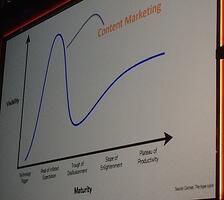
Pulizzi then transitioned to the current state of content marketing. He used Gartner’s Hype Cycle to illustrate the adoption curve of most new technologies. He showed where content marketing sits on the curve today (see photo above). Doug Kessler wrote an article that analyzes this much better than I can. But, the quick version is that things are going to get tougher for content marketing in the immediate future.
Without the Struggle, There Can Be No Progress

According to the model, we’re past the initial hype of content marketing and realities are setting in. One of the biggest struggles in getting buy-in from executives is the fact that it’s a long-term play that requires patience. Many marketing leaders abandon the practice when they don’t see quick results.
According to Pulizzi, we’ll likely start seeing some of the greatest failures in content marketing. But, we’ll also see some of the greatest successes for those that stick with their programs. “If there’s no struggle, then there can be no progress,” Pulizzi pointed out.
To show how we’ll progress, Pulizzi previewed stats from the upcoming annual research report from CMI and MarketingProfs. It shows the benefits for companies that have the following:
- Documented strategies = 4x more effective.
- Editorial mission = 3x more effective.
- Clear success metrics = 3x more effective.
- Content marketing budget = 2.5x more effective.
We Don’t Need More Content Marketers … We Need Passion!
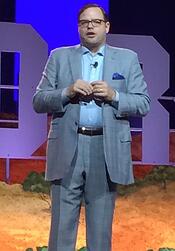
Jay Baer got our attention when he said, “We don’t need more content marketers.” As time goes on, we’re all getting better at content. We’re hearing the same messages, learning the same best practices, and attending the same conferences.
So, how do you stand out when we’re all churning out the same type of content? Passion. It separates the good from great; passion will set you apart.
Baer uttered the question that became the biggest theme of the conference: Are you making content, or are you making a difference? We are in a position to make a difference with our content. So, it’s up to us to do it.
Create the Least Amount of Content for the Maximum Return

Kristina Halvorson believes that we’re struggling with content marketing. Why? Because we assume content will solve all our problems. So we create more and more. Our content marketing strategy should start by answering “Why.” The strategy then acts as the guardrails to keep our content in line.
We don’t have to be everywhere doing everything. Marketers want to say yes to everything, but Halvorson stressed that there is a power in saying no. We need to learn how to make great choices and to focus on our content. Another theme, originated by Robert Rose, was the idea of creating the least amount of content to get the highest return.
Focus on the Valleys

Andrew Davis extended the “less is more” idea to content distribution. We’re addicted to chasing data spikes. This drives the “vomit content distribution strategy,” in which we promote our content everywhere at the same time.
The problem is that we’re focused on the wrong goal. Davis said, “Our content marketing strategy is not defined by the height of our peaks. It’s defined by the depth of our valleys.” Build momentum that will smooth out the graph into an upward trend.
Do this over time by focusing on one channel at a time. He advises leveraging the half-life, or the time it takes for the audience’s interest to fall to half of its peak value. In other words, track the growth of interest. You’ll see it plateau and then fall (see photo below). Once you get to the half-life point, start your promotion with the second channel. Follow this until you run through all your channels or you no longer see growth.
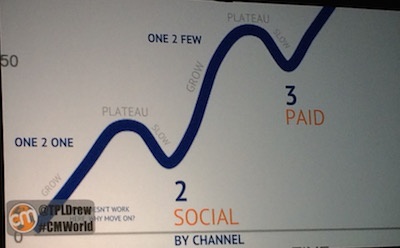
Make a Difference
Joe Pulizzi repeated Jay Baer and challenged us: Make a difference. He believes that we’re in a unique position to change the world in a way that others aren’t. Many sessions explored how to create difference-making content. Here are a few examples:
- Ann Handley: Tell bigger, braver, bolder stories because the biggest missed opportunity in marketing is in playing it too safe.
- Scott Stratten: Don’t be first., but be right first. Ethics still matter. Stand up for what’s right in business.
- Jay Acunzo: Everyone can create content, but does your audience want to consume it? To create more “stuff,” don’t take shortcuts. Ask yourself what story you want to tell, not the result you want to see.
- Rajiv Chandrasekaran: Good stories come down to fascinating characters, compelling human experiences and setting the proper context. Above all, be authentic.
- John Cleese: Embrace your unconscious mind. Break away and get some space. Get past the thoughts that consume your mind and ideas will come. Return to your analytical mind to figure out which ideas are great and worth pursuing. Cleese summed it up with, “It’s getting harder and harder to do these days…but good luck anyway!”
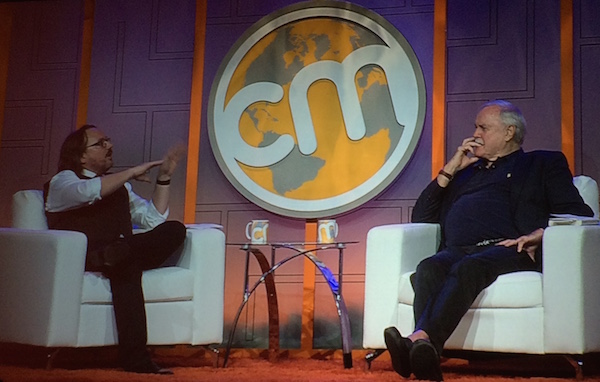
What inspired you the most at Content Marketing World 2015? What takeaways are you going to put in place first? To echo Pulizzi’s challenge, how are you going to make a difference? Share your thoughts in the comments below.
Note: This post originally appeared on the PR 20/20 blog.
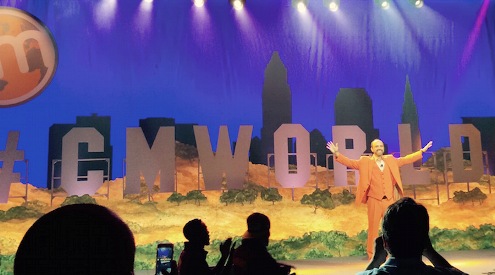
Pingback: Content Inc.: How to be Successful by Growing Your Audience First